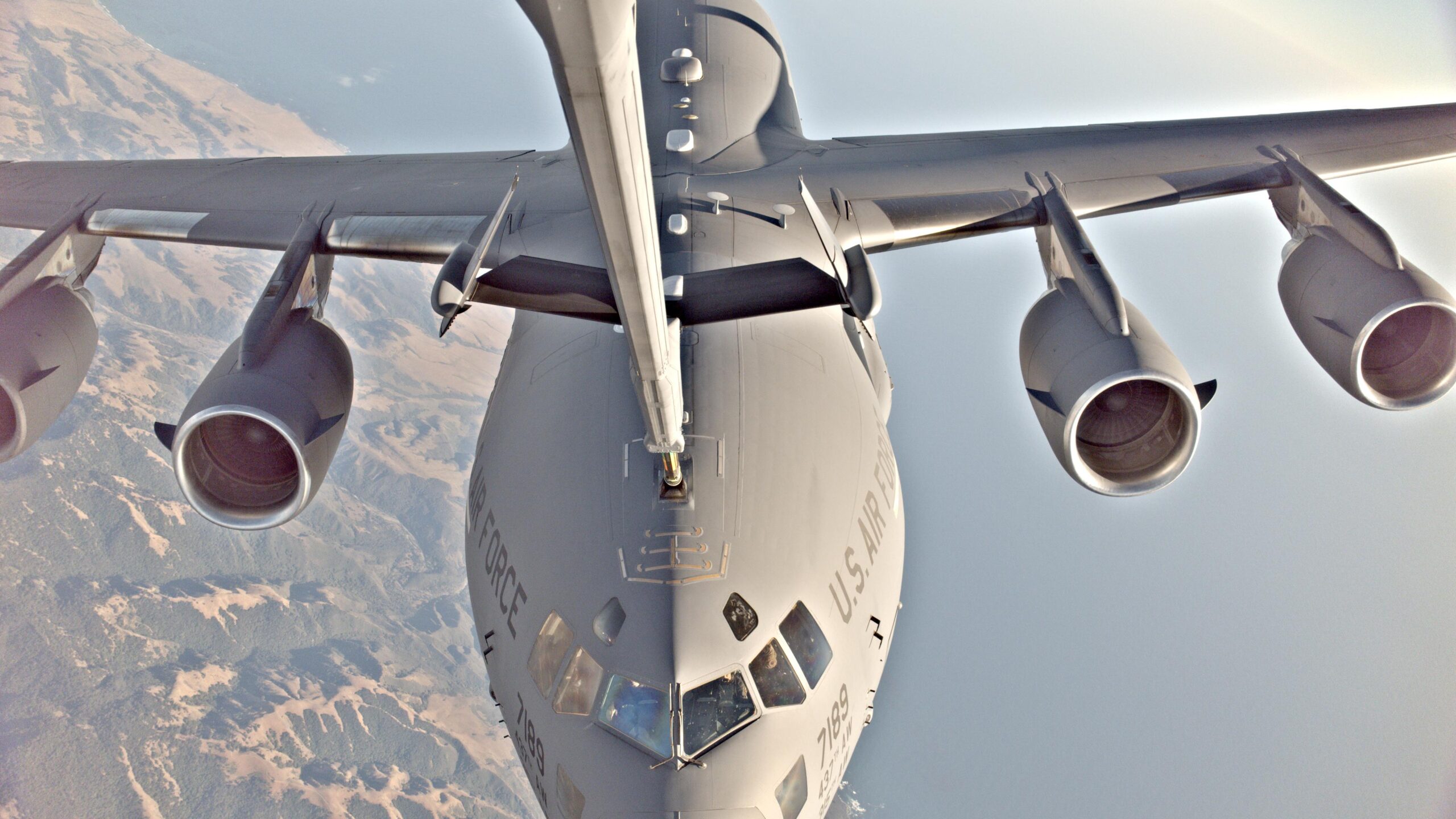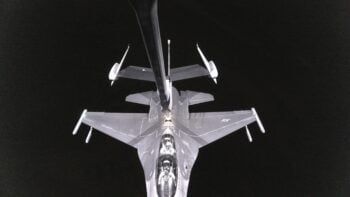
A two-dimensional representation of the 3D image that boom operators will see in the KC-46’s Remote Vision System 2.0. (Boeing)
EVERETT, Wash. — In May 2018, a group of defense reporters visited Boeing’s KC-46 manufacturing plant here in Everett, Wash., just months after the Air Force disclosed a major problem with a critical system that provides imagery to boom operators during the refueling process.
The message imparted by Boeing officials then was simple: A software fix, which would be available in months, was all that was needed to right the system.
At the time Air Force officials vehemently and publicly disagreed, and, it turned out, Boeing was wrong. The issue was more severe and would take far longer to rectify. After two more years of sometimes heated disputes with the Air Force, including a stern letter from the service’s top general to Boeing’s chief executive, the company agreed in May 2020 to completely redesign the KC-46’s Remote Vision System on its own dime.
Now, the company is ready to show off an early prototype of what it’s calling the Remote Vision System 2.0, giving a glimpse of it to a handful of reporters who were invited back to Everett on Dec. 20. And although the technology on view exhibited a major step up from the legacy system, the visit also highlighted a defrosting in the relationship between the Air Force and Boeing, with officials from the Air Force’s KC-46 program office and the operational community taking part in the tour to share their overwhelmingly positive thoughts on RVS 2.0.
RVS 2.0 provides a “quantum leap” in camera technology, said Lt. Col. Joshua Renfro of the Air Force’s KC-46 cross functional team. “We’re very confident in the product. We like where it’s going, and we really like what this is going to deliver to us down the road,” he told reporters during the visit. (Breaking Defense accepted travel and hotel accommodations from Boeing.)
James Burgess, Boeing’s vice president for the KC-46 program, acknowledged that the relationship between Boeing and the Air Force hit a rough spot after numerous technical problems were identified during testing, with the disagreement over how to fix RVS emerging as “most significant” source of friction between the two. However, “I think the approach that the company has taken with RVS 2.0 has really helped to restore it back to a very healthy, productive partnership,” he said.
Renfro agreed, stating that the parties have moved from an “adversarial relationship” to “more collaboration, more partnership.” Throughout the visit, Renfro and other Air Force officials underscored the service’s role in helping to design RVS 2.0 and expressed confidence in the ability of the KC-46 to conduct its missions even with the more limited vision system. Meanwhile, at multiple times Boeing officials deferred to the airmen present when asked about the capabilities of both the old and new versions of RVS, requesting that the servicemembers provide their views instead.
Although the agreement on RVS 2.0 appears to have healed the rift between Boeing and the Air Force, the new system has already hit some snags and has a long road ahead of it.
Supply Chain Woes
In October, the Air Force disclosed a 19-month delay to the program, with the projected date for “operational military flight release” slipping from March 2024 to October 2025. The service linked that setback to supply chain problems and projected delays associated with the Federal Aviation Administration certification process.
Burgess attributed much of the delay to the “[lack of] availability of the hardware to build up the cameras and display boxes that are required for lab testing.” When asked whether Boeing was concerned that RVS 2.0 supply chain issues could slow down KC-46 production in the future, he said “it’s something we’re going to have to manage, for sure,” but declined to give further details.
Dave Schreck, who oversees the Collins Aerospace’s avionics business, which produces both versions of the RVS, said he anticipates electronics and chips to become more widely available in mid-2023.
Meanwhile, the Air Force has yet to sign off on a critical design review of the RVS 2.0 system — a necessary milestone for solidifying the design of the system before a production-representative prototype is built and assessed. Kyle Ford, Boeing’s KC-46 RVS program manager, said Boeing was in “active discussions” with the Air Force on finalizing the CDR, but declined to provide a timeline on when the review would officially be closed out.
After CDR, Boeing and Collins will create the first prototype RVS 2.0 that will be installed on an airplane and go through developmental testing, said Lt. Col. Zachary Schaffer of the KC-46 Program Office.
When that’s finished, the system will begin the process of obtaining a supplemental type certification from the Federal Aviation Administration as well as go through additional tests to meet requirements for the operational military flight release milestone, he said. Only then will the Air Force will be ready to integrate RVS 2.0 on the production line and start retrofitting operational KC-46s with the technology.
While the initial RVS 2.0 tech looks promising, Renfro acknowledged that the Air Force won’t be able to definitively say what it delivers in terms of combat capability until it moves through developmental and operational tests.
“But we’ll put it through the paces, and I have every confidence it’ll bring us quite a bit,” he said.
A ‘More Immersive’ Vision System
In legacy tankers like the KC-135 and KC-10, the boom operators look out a window at the back of the tanker as they refuel aircraft, relying on their eyesight as they steer the tanker’s boom into a receiver aircraft. The KC-46 alters that paradigm, moving boom operators to a refueling station near the cockpit where they receive visual cues from the Remote Vision System — a series of optical cameras and infrared sensors that provide imagery to the boom operator.
While the RVS is more technically complicated than simply looking out a window, there are operational benefits that come with the sensor suite. For example, the KC-46 will be able to conduct “covert” refueling operations in pitch black darkness, with the tanker using its longwave infrared cameras to see the boom and guide it into a receiver aircraft, and the pilot in a receiver aircraft donning night vision goggles to be able to see the tanker. (Currently, the Air Force does not use the KC-46 for covert refueling operations due to limitations with the vision system.)
However, for the KC-46’s legacy RVS, certain lighting or weather conditions can actually make it more difficult to refuel a receiver. If the sun is at a high angle, or if the tanker is flying over water or a thick blanket of clouds, light or shadows can reflect onto the receiver aircraft and partially obstruct a boom operator’s view, said Ernest Burns, Boeing’s test and evaluation chief boom operator.
“You don’t have the option and the luxury in an operational environment to keep going in a heading which will be best conducive to mitigating those environments. If you do that in a combat environment, you could be flying into bad territory and you really don’t want a tanker to do that,” he said.

A two-dimensional representation of the 3D image that boom operators will see in the KC-46’s Remote Vision System 2.0 during night operations. (Boeing)
The new RVS 2.0 aims to rectify those problems by swapping out the current RVS’s black and white boom cameras with two color 4K cameras and switching out its infrared sensors with more powerful versions. Instead of setting those cameras on an angle as in the original RVS system — a position the Air Force later found caused distortion to the imagery — the cameras will be placed flush against the aircraft.
The panoramic camera system, which provides imagery of incoming aircraft, will also have its cameras replaced with the new visual and infrared tech used for the RVS 2.0 boom camera system.
Over the summer, Boeing and the Air Force outfitted a KC-46 with the new cameras that will be used as part of the RVS 2.0 sensor suite while at the same time retaining its legacy cameras, Burns said. It then flew that tanker from the Pacific Northwest down to California, giving a split-screen comparison between imagery from the old and new camera suite.
RELATED: Air Force backtracks, now says its paying for KC-46 panoramic camera fix
“Everyone really wanted to stress those cameras and see what they look like. And as you can see looking at the baseline system and the new RVS 2.0 cameras, the dynamic range of these cameras is phenomenal,” he said as the video played for reporters. Burns pointed to footage where blown-out imagery from RVS 1.0 looks crisp and clear with the new camera suite. “They’re able to adapt to that changing environment,” he said.
Beyond the cameras themselves, RVS 2.0 will feature a more powerful video processing unit and graphics processing unit — a necessary upgrade to ensure the imagery remains crisp and clear as it is processed and sent to the boom operator, Ford said. Additional fiber optic cables will also be added to the aircraft to satisfy the greater bandwidth requirements.
One of the biggest changes in RVS 2.0 is the overhaul of the displays the boom operators look at during the refueling process. Currently, boom operators wear 3D glasses and “[look] directly at an LCD monitor which is projecting in 3D,” Ford said. But after evaluating multiple ways to display the camera imagery, the Air Force and Boeing coalesced around an “indirect view” display where an LCD monitor projects 3D imagery to a curved mirror, which provides more depth perception to the user.
“Part of that, I think, was because of the legacy experience of looking at a window,” Burgess said. “So we wanted to do something that that provided more immersive experience for the boom operator, something that felt more true to life than just looking at a flat panel display.”
Reporters on the tour donned 3D glasses to try out the new display system, staring into an angled mirror from which an image of an F-16 appeared to jut out from the screen, making contact with a KC-46 boom. The picture was clear, with the 3D depiction appearing true to life and no distracting shadows or reflections of light.
And while not as operationally important to the refueling mission as new cameras and displays, Burns and Ford noted the new RVS station includes some small upgraded creature comforts — most notably in the form of a center console where 3D glasses can be stored as well as cupholders.
Lockheed Martin projects potential $1 billion loss on classified program
Lockheed CFO Jay Malave said the company currently expects the program to become profitable on an annual basis around the 2028 timeframe.


























